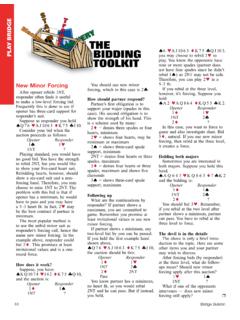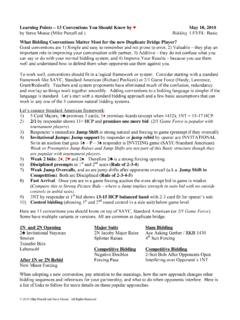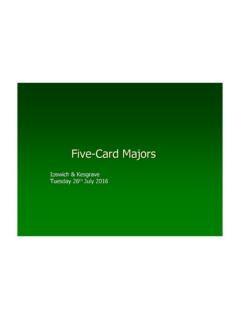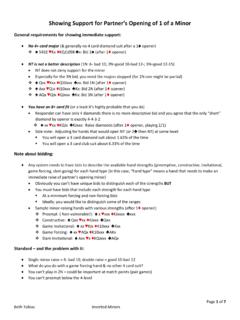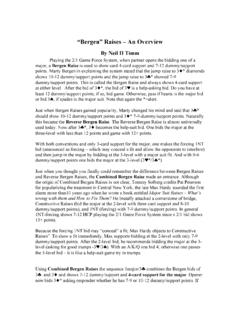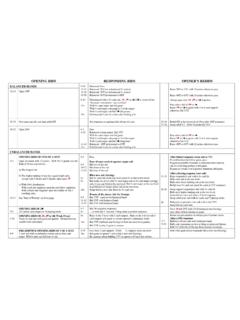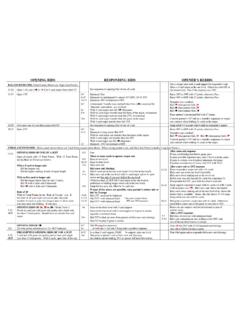Transcription of Two Over One Game Force (2/1) - Bridge Club Live
1 Page 1 of 12. Two over One Game Force (2/1) What It Is And What It Isn't A word of explanation first. This is a definition of what the system is and what it is not because there are a number of misunderstandings in this area. This is not an article on how to play 2/1 (altho a lot can be inferred just by knowing what the basics of the system are and you can develop your 2/1. system just from this). This bidding system is in common use in the United States but is not yet ter- ribly common in the rest of the world (as of 2012) altho it is catching on, es- pecially at the top level. Saying I play 2/1' is similar to saying I play Acol'. or I play Standard American' not definitive of exactly what you play but it does set a framework or general approach. I. What It Is A system can be called 2/1 if it meets two criteria and two only: 1. The response of 1NT to 1H or 1S is forcing (note: this, of course, says 5. card majors too) and 2.
2 The Two over One suit response is either: forcing to game (Hardy-style). or forcing to game unless responder rebids his/her suit (Lawrence-style). No more and no less. The argument for the forcing NT (this is an invention of Alvin Roth who also invented 5 card majors, the negative double, the unusual NT, and maybe even the precursor of 2/1 and was probably the finest bidding theorist the world has ever seen) is that, if responder has 2 cards in the major opened, a contract of 2 of that major, even if only a 5-2 fit, is at least as good a contract as 1NT (analogous to the weak transfer to a major you are often willing to risk a 5-2 fit there too) and that will often be responder's rebid if opener re- bids a new suit at the 2 level without reversing. If the responder has a singleton or void in the opened suit (with three or more, you would usually raise or make a Two over One response), the hand most likely belongs in a suit contract in some other suit and not 1NT (altho 1NT will sometimes score better than two of a suit, two of a suit will be the better contract at least as often in MPS and is generally better in IMPS) and the 1NT forcing mech- anism is likely to get you to a contract that's quite playable.
3 The forcing NT. should normally be used on any responding hand, except raises, of 6-12. points. 1. Page 2 of 12. Opener's rebid over a forcing NT response can be to repeat the major if it's at least 6 cards long and the opener can't envision a game in the hand (is rel- atively minimum), a 4 card heart suit (if the opening was 1S), or a 3 (yes, 3). card minor as well as the strong jump shifts or an invitational rebid of a jump to 3 of the major or an invitational rebid of 2NT. If responder has a balanced hand of a good 10-12 points, he/she can rebid 2NT (rather than the direct 2NT ala Acol without Jacoby 2NT) over a 2 of a suit rebid by opener. This, of course, isn't forcing . A rebid by responder (immediately after 1NT and opener's rebid at the two level) of a new suit isn't forcing either and opener should not raise unless there still might be a game in the hand (this is much more likely if respon- der's next response is 2H than if it's a minor at the two or three level).
4 This re-response shows a minimum of 5 cards in the suit altho it's probably 6. or more, especially in a minor. The Two over One response in a suit (from which the system got its name). allows very intricate investigation of slam. For example, in the auction 1S . 2C; 2D 2S, the hand is forced to at least 4S but, if either side is the least bit interested in slam (in fact, according to the principle of fast arrival which is used frequently in 2/1, a bid of 2S is stronger than a bid of 3S altho both Force to 4S), a cue bid at the three level can be made (or possibly something else depending on partnership understanding). Opener also can use the prin- ciple of fast arrival, as mentioned above, so, for example, 1S 2C; 2D 2S;. 4S is weaker than 3S (it doesn't deny the possibility of a slam, it simply says I've got a poorish opening hand but responder can carry on if very strong). Opener is not expected to exceed two of his/her suit with a minimum hand except possibly with 2NT (a small balanced hand) and then only when play- ing a strong NT (note: when playing the weak NT, opener never exceeds two of his/her suit with a minimum hand whether the response was 1NT, a two over one, or 1S over 1H).
5 However, you can make it a rule that even the small balanced hand with 5 cards in the major will also never exceed 2 of the opened suit even when playing the strong NT and that really isn't misrepres- enting your hand at all you have a minimum hand and nothing else to bid below 2 of the major. Note that: 1. Opener's rebidding the opened major doesn't guarantee that he/she has a minimum or 6 or more cards in the suit, just that there is nothing else to rebid (but it will usually be a fairly minimal sort of hand) and 2. Even if you are playing Lawrence-style, a 2/1 becomes forcing to game when opener shows more than a minimum by his/her 2nd 1. 2. Page 3 of 12. bid. As an example: 1H 2C; 2S 3C is still forcing to game playing Lawrence-style even tho responder has rebid his/her suit because opener showed extra strength by the reverse (opener could pass in the auction 1H . 2C; 2H 3C or even 1H - 2C; 2D - 3C). II.
6 What It Isn't Two over One Game Force dictates nothing about the range of the opening NT (altho it's usually played with one of 15-17 high card points and a bal- anced hand. It is, after all, an improvement on Standard American and the thought was to start with Standard American and then add the improve- ments). It does not necessarily use Inverted Minors altho it's usually played that way. Some people think Inverted Minors are easier to use if played with the weak NT. The opening two of a suit bids don't necessarily have to be the Standard American bids where 2C is the only strong bid and the other three suits are weak 2s. You could, if you so desired, play 2/1 with the traditional Acol Strong Twos (altho why you'd want to is a mystery), or you could use the Benji (or Reverse Benji) two bids, or something altogether different. It also doesn't require you to use 2NT to show 20-21 HCP (High Card Points) in a balanced hand altho, being based on Standard American, it's usually played that way.
7 It can, for example, use 21-22 HCP instead or it can use it for whatever purpose suits you (as long as it's a very strong balanced hand because that bid is needed to fill in the NT bids unless you use Benji two bids when both 2C and 2D can also have NT ranges so an opening 2NT. will then be freed up for something else). It also does not necessarily use weak jump responses to one of a suit. The original Two over One system was popularized by Max Hardy (altho it was invented by Richard Walsh) and he liked weak jump responses but he spe- cifically says that they're not part of the system. Mike Lawrence modified the system slightly as mentioned above and to use the standard, rock-crusher jump shift by responder (because, as he said, I'm not fond of the preemptive jump shift' and he likes the other responses to be limited by the jump shift). 1. Page 4 of 12. One other thing it doesn't necessarily include is light 3rd seat openings or 5.
8 Card majors in 1st or 2nd position that might only be 4 cards in 3rd or 4th posi- tion altho you can play it that way if you wish. Incidentally, Edgar Kaplan has an excellent presentation of light 3rd hand openings in his book about the Kaplan-Sheinwold System (he didn't believe they should be made in one of a suit but he advocated slightly unusual weak twos in 3rd seat and also said that the requirements for the weak NT could be lowered in this situation). Some of these things were in some versions of Hardy-style and not in others so are not necessarily an integral part of the system but the two criteria above are common to both Hardy-style (in all of its incarnations) and Lawrence-style. 1. 2. Page 5 of 12. III. What Can You Expect if You Agree to Play 2/1 with someone You can certainly expect that you'll be playing the basics of the system the forcing NT (which says 5 card majors) and the Two over One responses as forcing to game or forcing to game unless responder rebids his/her suit (ex- cept when opener shows more than a minimum by his/her rebid in which case it's always forcing to game).
9 In fact, the basic thing to agree with part- ner is do you play Hardy-style which few people in America do now or do you play Lawrence-style - Mike Lawrence's improvements' or do you play either of the styles' except - or do you play something different? If you play Hardy-style, you can expect that Two over One responses to all opening bids of 1 of a suit are unconditionally forcing to game (defined as forcing to 3NT, 4 of a suit, or penalizing the opponents) regardless of the opening suit, a strong NT of 15-17 HCP, Inverted Minors, Standard Americ- an two bids (strong 2C and 3 weak 2s), and weak jump responses. If you play Lawrence-style, you can expect that Two over One responses to all opening bids of 1 of a suit are forcing to game unless responder rebids his/her suit (altho see above), a strong NT of 15-17 HCP, Inverted Minors (altho Mike Lawrence doesn't mention them in his book), Standard Americ- an two bids, and strong jump responses.
10 Regardless of the style', you are most likely playing Jacoby 2NT the 2NT. response over 1 of a major doesn't make any sense as the invitational to 3NT. bid that it normally is in Acol or modern Standard American (if either is not using a special-meaning 2NT response to 1H or 1S). 1. Page 6 of 12. IV. Is it complicated? No but you can make it as complicated as you wish, as is the case with most bidding systems. Almost everything is logical once the basic principles of the bidding system have been laid out (like with almost all decent bidding systems). It's not necessary to have many predefined sequences any more than it is with Acol or Standard American. Experienced players will see the logic almost immediately and that's enough. So you can play a decent game if you agree Hardy-style or, maybe, a slightly better one if you agree Lawrence-style it's only a little more complicated if you pick and choose. If you have a long-term partner, you'd probably want to clarify at least some of the sequences further.
